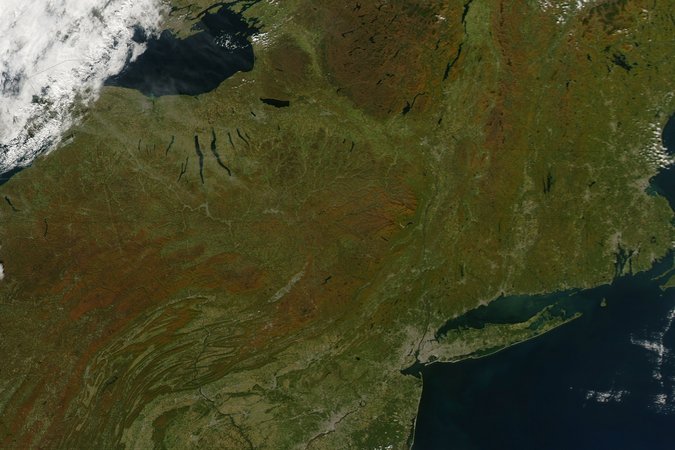Carbon Pricing 101
An introduction to carbon pricing, including carbon taxes and cap-and-trade programs, the benefits and design of pricing policies, and applications around the globe.
What Is Carbon Pricing?
Carbon pricing is a climate policy approach used in a number of countries and subnational jurisdictions (regions, states, provinces, cities) around the world. Carbon pricing works by charging emitters for the tons of emissions of carbon dioxide (CO₂) for which they are responsible. CO₂ is emitted largely through the combustion of fossil fuels used for electricity generation, industrial production, transportation, and use of energy in residential and commercial buildings.
2021 United States Carbon Dioxide Emissions from Energy Consumption by Sector

Comparing Carbon Taxes and Cap-And-Trade Programs
Carbon pricing policies traditionally take two forms: carbon taxes and cap-and-trade programs.
A carbon tax is a price set per ton of carbon or, more commonly, per ton of CO₂ emitted. Because CO₂ emissions from the combustion of fossil fuels are proportional to the carbon content of the fuel, a carbon tax is, in effect, a tax on CO₂. A $1 tax per ton of CO₂ is equal to a $3.7 tax per ton of carbon, because carbon constitutes roughly 3/11 of the weight of CO₂.
A cap-and-trade program limits the total amount of CO₂ that can be emitted by certain facilities. In a cap-and-trade program, the government issues a limited number of emissions allowances (also known as permits), each of which grants the holder the right to emit one ton of CO₂. Allowances can be distributed in a number of ways: they can be directly allocated to firms or facilities (a concept called free allocation of allowances) or sold through auction markets. The limited, government-controlled supply of allowances “caps” the total amount of emissions. Allowances can be traded, and the sales and purchases (supply and demand) of allowances yield a market price for allowances—essentially the price of one ton of CO₂ emissions.
Some cap-and-trade programs include provisions for the banking and borrowing of allowances over time: permits issued in one year can be submitted to account for emissions in later years (banking), and permits for future years can be issued and used in the current year (borrowing). When banking and borrowing take place, emissions during a specific year may be greater or less than the number of allowances issued in that year, but over time, the emissions and allowances are balanced. Banking and borrowing gives firms more flexibility in methods of compliance and reduce the costs of meeting a cumulative emissions target.
Carbon taxes and cap-and-trade programs primarily differ by the type of certainty they provide. Carbon taxes provide price certainty, as entities subject to the tax know how much they’ll have to pay per ton emitted—but simply setting a tax rate doesn’t guarantee any particular level of emissions reductions. Cap-and-trade programs, on the other hand, set a cap on emissions and therefore provide quantity certainty—but price fluctuations under the trading market structure can provide a less solid basis for business planning decisions. Hybrid systems, however, can be used to reduce price or emissions uncertainty. Under cap-and-trade programs, price floors and ceilings have been proposed and utilized to prevent prices from being “too low” or “too high.” Carbon taxes can also be designed to automatically adjust if actual emissions miss some predetermined emissions path.
Benefits of Carbon Pricing
Carbon pricing policies—carbon taxes and cap-and-trade programs alike—have several attributes that make them generally more efficient, or less costly, than other potential policies to reduce carbon dioxide emissions (such as technology mandates, direct regulations, subsidies to zero-carbon energy sources, and others). A few of these key attributes are discussed below.
Flexibility
Carbon pricing allows firms to choose the most efficient method to reduce (or not to reduce) emissions in response to the carbon price. Under other policies, such as technology mandates, a regulator chooses a single method for a wide set of firms. Such one-size-fits-all approaches may lead to unnecessarily costly reductions for some firms if cheaper methods to reduce emissions exist.
Equal Marginal Costs of Abatement
An economy-wide carbon price applies a uniform price on CO₂ emissions regardless of the source. As a result, the marginal abatement costs (the costs to firms of decreasing their emissions by one unit) are equalized across firms and sectors. This is a necessary condition for minimizing the overall costs of emissions reductions. Regulations often imply different marginal abatement costs across firms and sectors: if one sector has a regulation with very high marginal abatement costs, it may be more cost-effective to remove that regulation and impose more stringent regulations in sectors with lower abatement costs. In practice, it would be very difficult for regulators to accomplish this, but it is an inherent quality of carbon pricing.
Encouraging Conservation
A carbon price encourages individuals and businesses to reduce their carbon emissions more than conventional regulations. A conventional regulation (such as a performance standard) sets a strict limit on emissions per unit of output, but does not provide incentives to reduce overall demand. In contrast, carbon pricing provides incentives to reduce emissions per unit of output, but also charges a price for every additional ton of CO₂ that is not reduced through increased efficiency. Therefore, the price of carbon-intensive goods (i.e., electricity or gasoline) will likely be higher under a carbon price than under conventional regulations, which encourages individuals and businesses to reduce their demand (to the extent possible). Thus, a carbon price encourages more conservation than conventional regulations.
Revenue
A carbon price creates a new revenue stream that can be used in a number of ways. Revenue use can significantly affect the economic costs and political feasibility of a carbon pricing policy. This is discussed in more depth below.

Options for Carbon Pricing Design
Beyond the choice between a tax and a cap, there are many policy options for how a carbon price would be applied in the economy, all of which have different impacts on overall cost, emissions reductions, revenues raised, and so on.
Price
According to economic theory, emissions pricing produces the highest net benefits (environmental, health, and other benefits minus economic costs) when the carbon price is equal to the marginal damage of carbon emissions, or the damage caused by adding one additional ton of carbon dioxide into the atmosphere. This would be accomplished either by setting the carbon tax equal to the marginal damage or, under a cap-and-trade program, by capping emissions at a level that leads to an emissions allowance price equal to the marginal damage. This marginal damage is often called the social cost of carbon (SCC).
Negative Externalities
When private decision makers cause harm to an unrelated third party, that harm is called a negative externality. For example, if a power plant generates electricity and sells it to its customers, the pollution it emits in the process may affect the health of neighboring communities. The health effects of this pollution would be a negative externality of the power plant’s electricity generation and sale.
Arthur Pigou’s seminal 1920 book, The Economics of Welfare, introduced the idea of taxing negative externalities. In his book, Pigou showed that taxing a negative externality at a price equal to the marginal damage internalizes the externality and maximizes overall welfare.
Stringency
Policy stringency is determined by the level of the tax rate (under a carbon tax) or the level of the emissions cap (under cap and trade) and how they change over time. A $50 carbon tax is more stringent than a $10 carbon tax: it will lead to lower emissions and higher costs. In determining stringency, policymakers face a tradeoff between environmental goals and the costs of meeting those goals. In the United States, policy stringency is often framed relative to international agreements or temperature goals: policy A will meet the 2025 Paris targets or policy B will limit warming to 2 degrees.
Coverage
The coverage of a carbon pricing policy determines which sectors of the economy and which emission types are covered by the carbon price. For example, the European Union Emissions Trading System cap-and-trade program covers CO₂, nitrous oxide (N₂O), and perfluorocarbons (PFCs) emitted by 11,000 energy-intensive plants in the electric power and manufacturing sectors across 31 European countries. Overall, the policy covers about 40 percent of the EU’s greenhouse gases. In comparison, British Columbia’s carbon tax applies to the purchase and use of fossil fuels regardless of end-use sector, covering about 70 percent of provincial greenhouse gas emissions.
Point of Regulation
The point of regulation of a carbon price determines exactly who is required to submit permits or pay the tax to the government. An upstream carbon tax would tax fossil fuel producers for the carbon content (and hence ultimate CO₂ emissions) of their products. A midstream tax would tax the first purchaser of fossil fuels in the supply chain. For example, a midstream tax would require a refinery to pay for the carbon content of all the crude oil it purchases. A downstream tax applies to the emitter: for example, coal-fired generators, industrial users, or households and businesses that use gasoline in their vehicles or natural gas in their homes and businesses. The administrative cost of a carbon price can vary widely by the point of regulation, but ultimately a carbon price is passed on to consumers regardless of the point of regulation. To learn more about the economics of the point of regulation, see this report by economist Gilbert Metcalf.
Revenue Use
With the exception of cap-and-trade programs that freely allocate allowances to firms, carbon pricing policies raise revenue. Both the overall economic costs and the distribution of those costs across segments of society are significantly determined by how the revenues are used. In this explainer, we take an in-depth look at the question of what to do with the revenues.
Other
Carbon pricing policies may include other design elements aimed at mitigating cost uncertainty under a cap-and-trade program or emissions uncertainty under a carbon tax, or reducing potential competitiveness issues under cap-and-trade programs or carbon taxes.
Carbon Pricing Programs around the Globe
As of March 2022, the World Bank’s Carbon Pricing Dashboard highlights 65 carbon pricing initiatives implemented or scheduled for implementation, with 45 national jurisdictions and 34 subnational jurisdictions covered by those initiatives. In 2021, these initiatives would cover 11.65 gigatons of CO₂ equivalent, representing 21.5% of global greenhouse gas emissions.
At the moment, the majority of global carbon prices take the form of cap-and-trade programs, the largest of which can be found in the European Union and the state of California. Carbon taxes are growing in popularity, however, and are now in place in the United Kingdom, several Canadian provinces, Sweden, and more.




